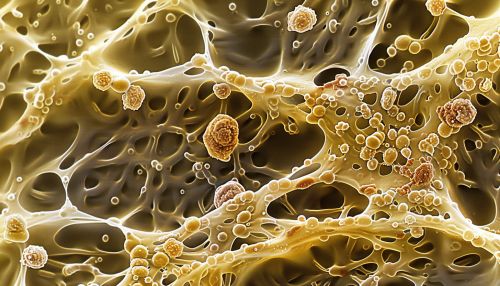Diffusive adhesion
Overview
Diffusive adhesion is a biological process that involves the movement of cells or organisms through a medium, typically a liquid, towards a surface to which they adhere. This process is a fundamental aspect of many biological systems, including the development of multicellular organisms, the formation of biofilms, and the spread of pathogens. It is a complex process that involves numerous factors, including the properties of the cells or organisms themselves, the properties of the surface to which they adhere, and the properties of the medium through which they move.
Biological Importance
Diffusive adhesion plays a critical role in many biological processes. For instance, during the development of multicellular organisms, cells must move and adhere to each other to form tissues and organs. This process is guided by a variety of signals, including chemical cues, mechanical forces, and electrical fields, which direct the cells towards specific locations and facilitate their adhesion to each other. Similarly, in the formation of biofilms, microorganisms move through a liquid medium towards a surface, where they adhere and form a complex, multi-layered community. This process is crucial for the survival and proliferation of many microorganisms, as biofilms provide them with protection from environmental stresses and enhance their ability to obtain nutrients.
Mechanisms
The mechanisms of diffusive adhesion are complex and multifaceted, involving a combination of physical, chemical, and biological factors. At the most basic level, the process involves the movement of cells or organisms through a medium towards a surface, driven by a variety of forces. These forces can include gravity, buoyancy, and Brownian motion, as well as active movements generated by the cells or organisms themselves. Once the cells or organisms reach the surface, they must adhere to it, a process that is facilitated by a variety of mechanisms, including the production of adhesive substances, the formation of physical structures that enable attachment, and the activation of specific cellular pathways that promote adhesion.


Factors Influencing Diffusive Adhesion
Numerous factors can influence the process of diffusive adhesion, including the properties of the cells or organisms, the properties of the surface, and the properties of the medium. For instance, the size, shape, and surface properties of the cells or organisms can affect their movement through the medium and their ability to adhere to the surface. Similarly, the properties of the surface, including its chemical composition, physical structure, and electrical charge, can influence the adhesion process. Finally, the properties of the medium, including its viscosity, temperature, and chemical composition, can also affect the process.
Applications
Understanding the process of diffusive adhesion has numerous applications in various fields. For instance, in medicine, it can help in the development of strategies to prevent the spread of pathogens, which often rely on diffusive adhesion to infect host organisms. In environmental science, it can aid in the management of biofilms, which can have both beneficial and detrimental effects on various ecosystems. In biotechnology, it can inform the design of materials and devices that interact with biological systems, such as medical implants and biosensors.
